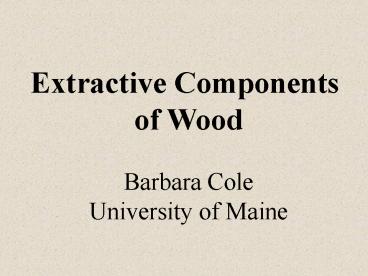Extractive Components - PowerPoint PPT Presentation
1 / 15
Title:
Extractive Components
Description:
Usually comprise 1-5% of the wood - Under genetic control vary by species ... Uses: Rosin, sizing agents. Lipid Extractive Components. II. Terpenoids: ... – PowerPoint PPT presentation
Number of Views:430
Avg rating:3.0/5.0
Title: Extractive Components
1
Extractive Components of Wood Barbara
Cole University of Maine
2
Major Components of Wood
3
Wood Extractives
- - Non-cell wall components
- Can be removed using solvents,
- e.g. pet. ether, acetone, ethanol, water
- - Relatively small molecules (lt C40)
- - Usually comprise 1-5 of the wood
- - Under genetic control ? vary by species
4
Lipid Extractive Components
I. Aliphatics
Fatty acids lt0.1
Fats (fatty acid esters of glycerol) 0.3-0.4
5
Fatty alcohols (C16-C28)
Waxes (esters of other alcohols)
Fatty acid
Alcohol
Suberin (polyester)
n 18-28
6
Lipid Extractive Components
II. Terpenoids primarily in softwood species
Monoterpenes (C10)
Uses Turpentine, flavor and fragrance chemicals
7
Lipid Extractive Components
II. Terpenoids primarily in softwood species
Diterpenes (C20) (0.2-0.8 of wood)
Uses Rosin, sizing agents
8
Lipid Extractive Components
II. Terpenoids
Triterpenes (C30) (5-30 in birch bark)
9
Phenolic Extractive Components
I. Simple Phenolics
10
Phenolic Extractive Components
II. Stilbenes
Stilbenes are generally very toxic! Primarily in
the heartwood of conifers.
11
Phenolic Extractive Components
III. Flavonoids
- - Flavonoids are the most abundant phenolics.
- Coloration in foliage and flowers, astringent
taste in unripe fruits. - Condensed tannins tanning agents, adhesives
12
Phenolic Extractive Components
IV. Lignans
Generally non-toxic and are very good
antioxidants.
13
Other Extractive Components
- Alkanes
- Proteins
- Monosaccharides and derivatives
14
Summary
- - Extractive components are small molecules
that can be - extracted with a solvent from wood, bark, or
foliage. - Generally, extractives are present in small
amounts. - Extractives vary tremendously within species,
between - species, and within trees.
- There are thousands of different extractives
present in - wood.
15
Softwoods vs. Hardwoods
Softwoods - Resin acids 40-45 of extractives -
Fatty acids 40-60 - Monoterpenes (turpentine) -
Phenolics Hardwoods - No resin acids or
monoterpenes - Fatty acids 60-90 - Phenolics































